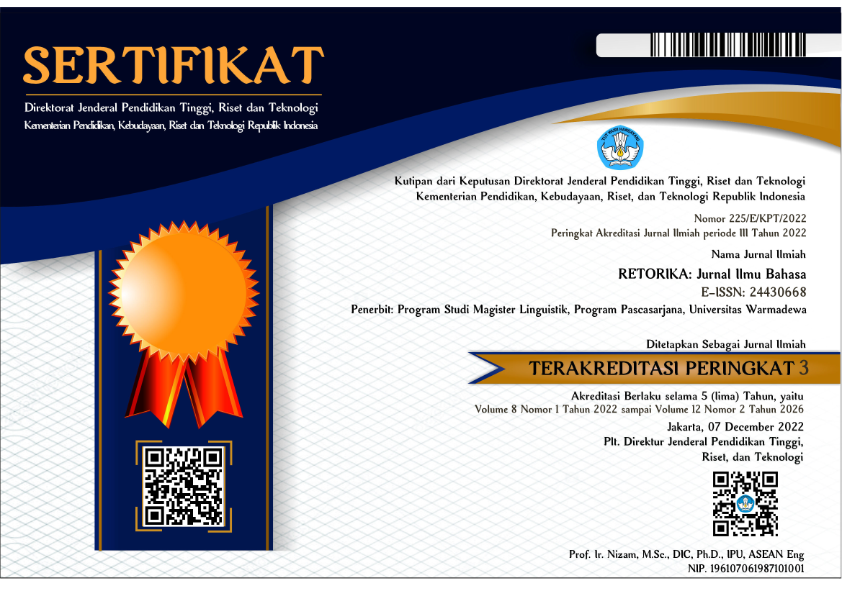A Natural Semantic Language Approach to Dawan Verb ‘To Take’
Abstract
This research investigates the study of Natural Semantic Metalanguage (NSM) to the verb mait 'to take' of Dawan - East Nusa Tenggara Province, Indonesia. Typically the study describes the semantic structure and the semantic role of the argument of the mait. I made use of Goddard’s theory of NSM (Goddard, 1997) in dealing with the verb analysis. Data were obtained from 5 Dawan native informants. Results of data analysis show that the verb of Dawan has a significant meaning in line with the concept of semantic of the verb mait "to take", oet "to cut", usik "to despoil", main " to pick up", kui "to waste", heut "to pick", so "to spoon", abakat "to rob", nakolo "to pilfer", mpoel "to throw", mbok "to pull", Nak Haen "dig", Muhabi "pinning", Huk "catch", and Iup "broken". The semantic structure based on the argument that fills the verb is if one "takes", the component mapping is "X does something on Y" and therefore this "Y moves through X" at the same time; X wants this; X does something like this.References
Allan, K. (2006). Metalanguage versus Object Language. Elsevier Ltd, (2), 31–32.
Anderson, V. B., Berez-kroeker, A., Emeritus, D. B., Campbell, L., Adjunct, K. W. C., Holton, G., & Emeritus, R. A. J. (2015). Working Papers in Linguistics (4th ed., Vol. 46). Department of Linguistics, University of Hawai‘I at MÄnoa.
Budiarta, I. W. (2012). KAJIAN TIPOLOGI BAHASA, (1948), 1–11.
Budiarta, I. W. (2016). COMPOUND WORDS IN DAWAN LANGUAGE, 2(1), 1–15.
Dgglwlrqdo, R. U., Derxw, L., Duwlfoh, W., & Edwards, O. (2016). Parallel Sound Correspondences in Uab Meto.
Durst, U. (2004). The Natural Semantic Metalanguage approach to linguistic meaning. Theoretical Linguistics, 29(3), 157–200.
Engelenhoven, A. V. A. N. (2010). THE MAKUVA ENIGMA : LOCATING A HIDDEN LANGUAGE IN EAST TIMOR 1, 2008, 161–181.
Farese, G. M. (2015). Hi vs. Ciao: NSM as a tool for cross-linguistic pragmatics. Journal of Pragmatics, 85, 1–17.
Goddard, C. (1997). Universal Suntax and Semantic Primitives. Language Sciences, 19(3), 197–207.
Goddard, C., & Wierzbicka, A. (2016). “ It â€TM s mine ! †. Re-thinking the conceptual semantics of “ possession †through NSM. Language & Communication, 56, 93–104.
Honours, B. A., Rsa, D., Rsa, C., & Ed, M. (2007). The Ecology of Language Planning in Timor-Leste A study of language policy , planning and practices in identity construction.
Sudipa, I. N. (2012). Makna “Mengikat†Bahasa Bali: Pendekatan Metabahasa Semantik Alami. JURNAL KAJIAN BALI, 2(Oktober), 49–68.
Tenis, H Ilyadim; Kroon, Yoseph B; Haan, J. W. (2018). Peran Semantis Argumen Klausa Verbal Bahasa Dawan Dialek Amanuban. SASYADA, Gadjah Mada Journal of Humanities, 2(2), 369–392.
Widani, N. N. (2016). Makna “ Mengambil †Bahasa Bali : Pendekatan Metabahasa Semantik Alami ( Msa ). RETORIKA, 2(1), 127–141.
Wierzbicka, A. (1996). Semantics : primes and universals, 500.
Wierzbicka, A. (2007a). Bodies and their parts : An NSM approach to semantic typology, 29, 14–65.
Wierzbicka, A. (2007b). Bodies and their parts: An NSM approach to semantic typology. Language Sciences, 29(1), 14–65.
Copyright (c) 2018 RETORIKA: Jurnal Ilmu Bahasa

This work is licensed under a Creative Commons Attribution-ShareAlike 4.0 International License.
This journal provides immediate open access to its content on the principle that making research freely available to the public supports a greater global exchange of knowledge.
All articles published Open Access will be immediately and permanently free for everyone to read and download. We are continuously working with our author communities to select the best choice of license options, currently being defined for this journal as follows: Creative Commons-Non Ceomercial-Attribution-ShareAlike (CC BY-NC-SA)
 Abstract viewed = 447 times
Abstract viewed = 447 times
 PDF downloaded = 287 times
PDF downloaded = 287 times

2.png)














